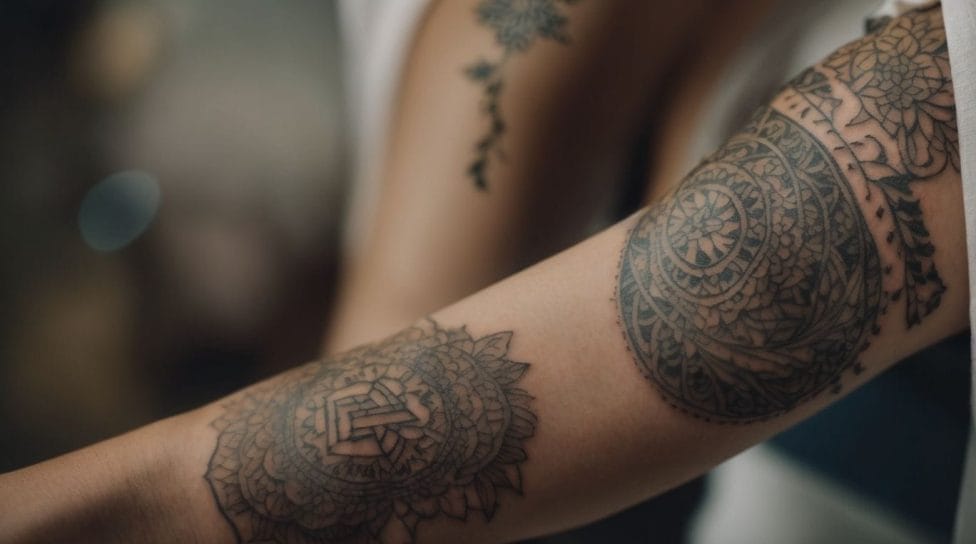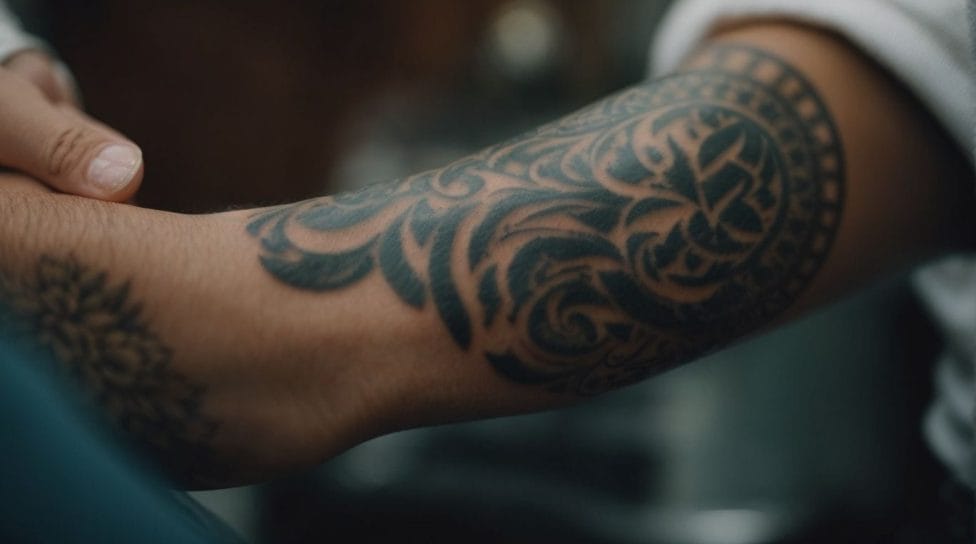When considering getting a tattoo, one of the most common concerns is the level of pain involved. Tattoos can vary in pain depending on various factors, including the location of the body. For those considering wrist tattoos, understanding the pain factor is crucial before deciding.
Pain levels associated with tattoos can differ from person to person due to individual pain thresholds and tolerance. While pain is subjective, certain body areas are more sensitive than others. The wrist is one such area that may cause some discomfort during the tattooing process.
The wrist is a relatively sensitive area due to the proximity of nerves and thin skin. This can result in slightly higher pain during the tattooing process. However, it’s important to note that everyone’s pain tolerance is different, and what may be uncomfortable for one person may be tolerable for another.
Several factors can influence pain levels during wrist tattoos, including the size and intricacy of the design, the skill of the tattoo artist, and your own physical and mental state. Being prepared and minimizing pain can help make the tattooing experience more manageable.
Preparation techniques such as using numbing creams or anesthetics can help reduce pain during the tattooing process. Choosing the right positioning for your wrist tattoo and mentally preparing yourself beforehand can also make a difference in your pain experience.
Once the tattoo is done, proper aftercare and following the healing process is essential. This includes regular cleaning and moisturization to prevent infection and promote optimal healing. Understanding what to expect during the healing process can also help manage discomfort or pain.
While wrist tattoos may involve some discomfort, proper preparation, technique, and aftercare can help minimize pain and ensure a successful tattooing experience.
Key takeaways:
Key takeaway:
- Tattoo pain varies from person to person: The pain experienced during a wrist tattoo can differ from individual to individual based on factors like pain threshold and sensitivity.
- Wrist tattoos can be more painful: The wrist is considered a sensitive area for tattoos due to the presence of nerves and thin skin. The pain level can be higher compared to other less sensitive body parts.
- Preparation helps minimize pain: Using numbing creams or anesthetics, along with mentally preparing yourself, can help reduce the pain experienced during a wrist tattoo. Proper positioning is also essential.
Understanding the Pain Factor of Tattoos

Photo Credits: Tattooineplanet.Com by Randy Harris
Understanding the Pain Factor of Tattoos is crucial before getting inked, especially on sensitive areas like the wrist. Several factors need to be considered, which include the location, size, and intricacy of the tattoo, personal pain tolerance, the artist’s technique, and proper preparation and aftercare instructions.
Regarding the location, areas with thinner skin, such as the wrist, tend to be more painful. Similarly, larger and more detailed tattoos can also be more painful as they require more time and precision during the tattooing process.
In addition, it’s important to note that personal pain tolerance varies from one individual to another. What may be painful for one person may not be the same for someone else. So, it’s essential to take into account your pain threshold before getting a tattoo.
Another crucial aspect is the artist’s technique. Experienced artists know how to reduce pain by using proper techniques and tools. By choosing a skilled and knowledgeable artist, you can minimize the pain associated with the tattooing process.
Lastly, proper preparation and aftercare play a significant role in mitigating pain and promoting healing. Following the artist’s aftercare instructions diligently can help alleviate discomfort and ensure a smooth healing process.
By considering all these factors, you can have a better understanding of the pain factor involved in getting tattoos, especially in sensitive areas like the wrist.
How Does Pain Differ from Person to Person?
Pain tolerance varies from person to person due to genetics, psychological factors, and individual pain thresholds. This divergence in pain experience explains how pain can differ from person to person. Some individuals may perceive tattoos as more painful than others. For instance, while one person may endure the pain well, another may find it unbearable. Various aspects like age, overall health, and prior pain encounters can also contribute to the perception of pain. It is crucial to acknowledge that pain is subjective, meaning it varies based on personal interpretation. As a result, what may be agonizing for one person might not be the same for another. Fortunately, tattoo artists can aid pain management by employing techniques to distract from the discomfort or using numbing creams.
Tattoos on the Wrist: Does It Hurt?

Photo Credits: Tattooineplanet.Com by Brian Roberts
Tattoos on the wrist can be painful due to the sensitive nature of the area. Does it hurt? The skin on the wrist is thinner and closer to the bone, making it more sensitive to tattoo needles. Pain tolerance varies from person to person, so the level of discomfort may differ. Some people describe the pain as a sharp or stinging sensation, while others find it more tolerable. To minimize discomfort, it’s recommended to choose a skilled tattoo artist, stay relaxed during the process, and follow proper aftercare. Pro tip: Consider getting a smaller or simpler design for your first wrist tattoo to gauge your pain tolerance.
Is the Wrist a Sensitive Area for Tattoos?
Yes, the wrist is indeed a sensitive area for tattoos. The thin skin on the wrist makes it more prone to pain, as there is a high concentration of nerve endings. Several factors, such as the individual’s pain tolerance, the size and complexity of the tattoo, and the skill level of the tattoo artist, can also affect the pain experienced. It is crucial to mentally prepare oneself and explore techniques such as using numbing creams or adjusting the positioning to minimize any discomfort. Additionally, following proper aftercare measures, including cleaning and moisturizing the tattooed area, can help facilitate the healing process and alleviate any potential discomfort.
Factors Influencing Pain Levels on the Wrist
Factors Influencing Pain Levels on the Wrist
Factors influencing pain levels on the wrist can vary from person to person. Some key factors include:
- Skin sensitivity: Individuals with sensitive skin may experience more pain while tattooing on their wrists.
- Bone proximity: The wrist has less muscle and tissue to cushion the bones, making the tattooing process more painful.
- Design placement: The specific location of the tattoo on the wrist can influence pain levels. Areas closer to the palm or those over prominent veins may be more painful.
- Tattoo size and detail: Larger, more intricate tattoos typically require longer tattooing sessions, leading to potentially higher pain levels.
It’s important to remember that pain tolerance varies, and what may be painful for one person may not be the same for another. Fun fact: Did you know wrist tattoos have become increasingly popular among men and women?
Preparation and Techniques to Minimize Pain

Photo Credits: Tattooineplanet.Com by Dennis Nguyen
Prepare yourself for a pain-free wrist tattoo experience! In this section, we will uncover the secrets to minimizing pain during the process. Get ready to explore the world of numbing creams and anesthetics, as well as the importance of proper positioning and mental preparation. With these techniques at your disposal, you’ll be able to approach your wrist tattoo with confidence and ease. Say goodbye to worries about pain, and hello to a smooth tattooing journey. Let’s dive in!
Numbing Creams and Anesthetics
Using numbing creams and anesthetics can help minimize the pain experienced during tattooing on the wrist. Here are some options to consider:
- Numbing creams and anesthetics: These topical creams and anesthetics can be applied to the wrist before the tattooing procedure. They work by numbing the skin and reducing pain sensations.
- Anesthetic injections: Some tattoo artists offer the option of local anesthetic injections to numb the wrist area. This can provide more significant pain relief during the tattooing process.
- Cold compresses: Applying a cold compress to the wrist before and during the tattooing process can help numb the area and reduce pain.
Remember, it’s important to consult with your tattoo artist and follow their recommendations for pain management. Every individual’s pain tolerance may vary, so finding the right method to minimize pain during the tattooing process is key.
Proper Positioning and Mentally Preparing Yourself
Proper positioning and mentally preparing yourself are essential in minimizing pain and discomfort when getting a tattoo. It is crucial to find a comfortable position that allows the tattoo artist easy access to the wrist area. Whether you sit or lie down, the key is to ensure that your wrist remains steady and easily accessible throughout the process. In addition, mentally preparing yourself is equally important. You can achieve this by focusing on relaxation techniques, practicing deep breathing, or listening to music. These techniques help to distract your mind from any potential pain or discomfort, leading to a more positive and comfortable experience when getting a wrist tattoo.
Aftercare and Healing Process

Photo Credits: Tattooineplanet.Com by Kevin Anderson
The aftercare and healing process of wrist tattoos is crucial in ensuring a successful and pain-free experience. In this section, we’ll unravel the secrets of proper cleaning and moisturization to maintain the tattoo’s vibrant appearance. We’ll also explore what to expect during the healing process, offering valuable insights to those considering or sporting wrist tattoos. Get ready to care for your ink like a pro and embrace the beauty of healed wrist tattoos!
Proper Cleaning and Moisturization
- Ensuring proper cleaning and moisturization is essential for the healing process of a wrist tattoo. Here are some steps to follow:
- Before touching your tattoo, thoroughly wash your hands.
- Gently cleanse the tattoo using a mild, fragrance-free soap and lukewarm water.
- Afterward, pat the area dry with a clean, soft towel. Remember to avoid rubbing or scrubbing.
- To maintain the tattoo’s moisture, apply a thin layer of fragrance-free, petroleum-based ointment.
- For optimal results, repeat the cleaning and moisturizing process 2-3 times a day or as advised by your tattoo artist.
Pro-tip: To avoid infection or damage to the healing skin, avoid picking or scratching your tattoo. Promote proper healing by consistently keeping the area clean and moisturized.
What to Expect During the Healing Process
- During the healing process of a tattoo on the wrist, there are certain steps to expect:
- Redness and Swelling: It is common to experience redness and swelling around the tattooed area. This is the body’s natural response to the trauma of getting a tattoo.
- Peeling and Scabbing: The tattooed skin will start to peel and form scabs as it heals. It is important not to pick at or scratch the scabs to avoid damaging the tattoo.
- Itching: As the tattoo heals, it may become itchy. It is crucial to resist the urge to scratch, as this can lead to infection or damage to the tattoo.
- Fading: The tattoo may appear slightly faded during the healing process. This is normal, and the tattoo will regain its vibrancy once fully healed.
- Complete Healing: The healing process can take 2 to 4 weeks, depending on the individual. It is crucial to follow proper aftercare instructions from the tattoo artist to ensure a successful healing process.
To ensure a smooth healing process, it is recommended to keep the tattoo clean and moisturized, avoid direct sunlight and swimming, and follow any additional instructions provided by the tattoo artist.
Some Facts About Do Tattoos on the Wrist Hurt?
- ✅ Wrist tattoos can be painful due to the sensitivity of the area. (Source: Lucky Deville Tattoo Co)
- ✅ The pain level of a wrist tattoo can vary depending on an individual’s pain tolerance. (Source: Byrdie)
- ✅ Areas closer to the bone or joints are more painful when getting a wrist tattoo. (Source: Byrdie)
- ✅ Eating a meal before a wrist tattoo session can help minimize pain sensitivity. (Source: Byrdie)
- ✅ The inner wrist near the palm is the most sensitive spot for a wrist tattoo. (Source: Byrdie)


